

Maximilian and Carlota: A Blog for Researchers. C.M. Mayo. February 27, 2014 Seattle WA Panel Discussion "Homesteading on the Digital Frontier: Writers Blogs" Associated Writing Programs Conference Room 615/616/617 Washington State Convention Center, Level 6 4:30 pm - 5:45 pm Writers present strategies on how to start a blog, where to get material, how to publicize a blog and add readers and followers, and how to sustain it over time.
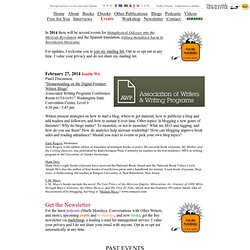
Customer Reviews: Maximiliano intimo: El emperador Maximiliano y su corte : memorias de un secretario (Al siglo XIX, ida y regreso) (Spanish Edition) About Catherine Mansell Carstens. Ways to use Hydrogen Peroxide in the Garden. The benefits of hydrogen peroxide for a garden can be useful for any kind of a garden, and any method of gardening.

Peroxide is great for plants that are planted in the ground, and it’s also great for plants in containers -- it is useful in hydroponic gardens, raised beds, and greenhouses. Similarly, peroxide for gardening applies well with all kinds of plants: a rose garden, herb garden, vegetable garden, orchard, shade trees, flower garden or lawn -- any or all of these would benefit from hydrogen peroxide. Peroxide works by releasing oxygen. It acts as an oxygen supplement for plants. It seems to really support both good health and strong growth for plants. Hydrogen peroxide can also help with soil fungus: it aerates the soil, and it is anti-fungal. Ways to use peroxide in the garden General fertilizer, either in plant water or sprayed on foliage. How much peroxide to use in the garden…. About us. (Clockwise from top left) Adam Kennedy, Kirsten Bradley, Michael Hewins, Ashar Fox, Nick Ritar) Milkwood is a permaculture enterprise based near Mudgee, NSW Australia.
Founded in 2007 by Kirsten Bradley and Nick Ritar with the intention to develop a small farm from scratch that would also be a working, kick-ass permaculture system, Milkwood is now bigger than just our little family. Sasha Woodsman. Google Image Result for. Ten Thousand Trees. Miguel León Portilla: Books, Biography, Blog, Audiobooks, Kindle. Miguel Leon-Portilla — TWAS ROLAC. Miguel León-Portilla. Professor Miguel León-Portilla is the foremost scholar on the language and culture of the Nahua people, also known as Aztecs, who had a well-established and distinguished civilization in Mexico long before the Spanish arrived in the early 16th century.

With probing intelligence, lifelong perseverance, political savvy and humanistic compassion, Dr. León-Portilla has brought "visions of the vanquished" to the forefront of scholarly consideration and public interest, resulting in a nascent understanding of the rich and vibrant culture of indigenous Mexican people from a perspective that amplifies and respects their voices. Dr. León-Portilla's academic career spans half a century. Currently, he is a professor emeritus at the National Autonomous University of Mexico.
Miguel León-Portilla. Miguel León-Portilla (born in Mexico City, February 22, 1926) is a Mexican anthropologist and historian, and a prime authority on Nahuatl thought and literature.[1] Career[edit] He wrote a doctoral thesis on Nahua philosophy under the tutelage of Fr.

Ángel María Garibay K., another notable researcher and translator of primary Nahuatl source documents whose publications in the 1930s and 1940s first brought Nahuatl literature to widespread public attention. Aztec thought and culture: a study of the ancient Nahuatl mind - Miguel León-Portilla. Tlamatini. The famous Nahuatl language translator and interpreter Miguel León-Portilla refers to the tlamatini as philosophers and they are the subject of his book Aztec Thought and Culture.
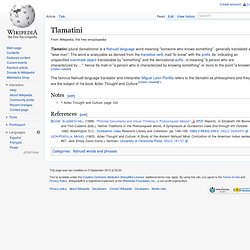
[citation needed][1] Notes[edit] Jump up ^ Aztec Thought and Culture, page 120 References[edit] Nezahualcoyotl. Nezahualcoyotl (Classical Nahuatl: Nezahualcoyōtl, He is best remembered for his poetry, but according to accounts by his descendants and biographers, Fernando de Alva Cortés Ixtlilxochitl and Juan Bautista de Pomar, he had an experience of an "Unknown, Unknowable Lord of Everywhere" to whom he built an entirely empty temple in which no blood sacrifices of any kind were allowed — not even those of animals.

However, he allowed human sacrifices to continue in his other temples. Early life[edit] The reconquest of Texcoco[edit] The campaign was divided into three parts. Achievements[edit] Monument to Nezahualcoyotl in the city of the same name. Huitzilihuitl. Huitzilihuitl [wit͡siˈliʔwit͡ɬ] (Nahuatl language; English: Hummingbird Feather) (d. ca. 1417) was the second tlatoani of Tenochtitlan, governing from 1396 to 1417,[1] (or 1390 to 1410 according to other sources).[2]
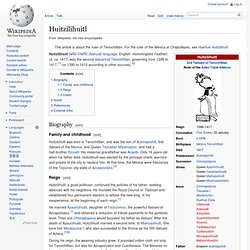
Jayavarman VII. Jayavarman VII (Khmer: ជ័យវរ្ម័នទី៧, 1125–1218) was a king (reigned c.1181-1218) of the Khmer Empire in present day Siem Reap, Cambodia.

He was the son of King Dharanindravarman II (r. 1150-1160) and Queen Sri Jayarajacudamani. He married Jayarajadevi and then, after her death, married her sister Indradevi. The two women are commonly thought to have been a great inspiration to him, particularly in his unusual devotion to Buddhism, as only one prior Khmer king was a Buddhist. Early years[edit] Jayavarman probably spent his early years away from the Khmer capital. Khmer Empire. The Khmer Empire, now known as Cambodia, was the powerful Khmer Hindu-Buddhist empire in Southeast Asia.
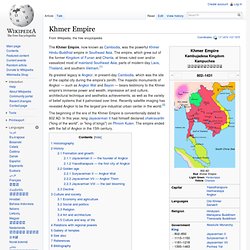
The empire, which grew out of the former Kingdom of Funan and Chenla, at times ruled over and/or vassalized most of mainland Southeast Asia, parts of modern-day Laos, Thailand, and southern Vietnam.[1] Its greatest legacy is Angkor, in present-day Cambodia, which was the site of the capital city during the empire's zenith. The majestic monuments of Angkor — such as Angkor Wat and Bayon — bears testimony to the Khmer empire's immense power and wealth, impressive art and culture, architectural technique and aesthetics achievements, as well as the variety of belief systems that it patronised over time. Recently satellite imaging has revealed Angkor to be the largest pre-industrial urban center in the world.[2] The beginning of the era of the Khmer Empire is conventionally dated to 802 AD. Ta Prohm. Ta Prohm (Khmer: ប្រាសាទតាព្រហ្ម)is the modern name of the temple at Angkor, Siem Reap Province, Cambodia, built in the Bayon style largely in the late 12th and early 13th centuries and originally called Rajavihara (in Khmer: រាជវិហារ).
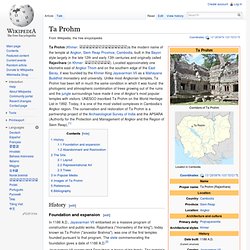
Located approximately one kilometre east of Angkor Thom and on the southern edge of the East Baray, it was founded by the Khmer King Jayavarman VII as a Mahayana Buddhist monastery and university. Unlike most Angkorian temples, Ta Prohm has been left in much the same condition in which it was found: the photogenic and atmospheric combination of trees growing out of the ruins and the jungle surroundings have made it one of Angkor's most popular temples with visitors. UNESCO inscribed Ta Prohm on the World Heritage List in 1992. Today, it is one of the most visited complexes in Cambodia’s Angkor region. Roomful of Shattered Buddhas. Ta Prohm HDR. Tree roots and ruins. Giant Sequoia Tree, Los Angeles, United States.
Sequoia Trees - Airport Terminal by NatureMaker - Go-To Buyers Guide. BigBangChallenge Astra Zéneca. Azoteas Vivas. ¡AIRE PURO! Cuántas veces hemos repetido esta frase al alejarnos de la ciudad… Es indiscutible que la calidad ambiental del aire en el campo es mayor que en la ciudad. Los malos hábitos y el estilo de vida de la ciudad han provocado que el aire esté cada vez más contaminado y ello está produciendo un sinfín de problemas, como el aumento de enfermedades (p.e.: respiratorias), efecto invernadero, etc. Por el simple hecho de vivir más cerca y depender de una manera más directa del medio natural que los rodea , los habitantes de los pueblos tienden a realizar una mayor reflexión sobre la repercusión de los impactos producidos por la obtención de las materias primas, la producción y eliminación de residuos, o los vertidos y emisiones realizadas por la industria y medios de transporte, que además siempre van ligados a un consumo excesivo.
La distancia entre el campo y la ciudad no solo se va haciendo tan aparente en este aspecto. 1. 2. 3. 4. 5. 6. 7. 8. 9. 10. 11. 12. 13. Ecotono urbano mexico - RESIDENCIAL. Nuevo negocio: huertos en las azoteas. Plantas de invierno. Conserva. Ha llegado el momento de preparar las conservas con los excedentes del huerto para poder utilizarlas durante los meses venideros en los que ya no habrá en el huerto hortalizas de verano frescas . Biozotea: Azoteas Verdes « AZOTEAS VIVAS.